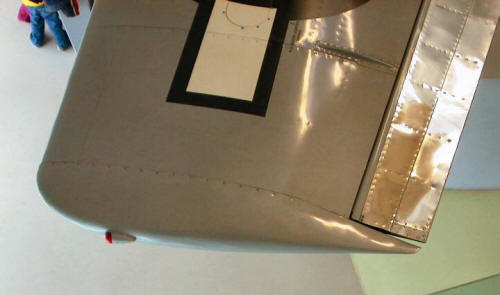text and photos by Martin Waligorski
Back to main article
A testimony to the quality of Hendon Mustang’s restoration can bee seen in this view. Despite the once widely-spread urban myth, high-performance US aircraft such as P-51 or P-38 were never finished entirely in bare metal. Aerodynamically important elements such as Mustang’s laminar-flow wing were puttied, sanded flush and then coated in aluminium lacquer. What you can see here is the faithful reproduction of this job on the fixed wing area, while flaps, ailerons and the wing root area remain unpainted.
View of the wing-to-fuselage joint. Note the curved line of its rear part where the wing root fairing goes
over the landing flap.
Port flap in the dropped position, showing clearly how it retracts under the wing root fairing.
Close-up of the upper wing area showing the red fuel filler cap and two-part hatch covering the gun compartment.
Detail of starboard aileron and trim tab.
Port wing tip with teardrop-shaped navigation light.
Close-up of the port aileron with visible two ”fences” on the wing’s upper surface.
Visible throughout in Mustang’s design is the care which North American designers approached the drag problem. Any drag-inducing feature found was addressed in one way or another, such as these small fairing over the three gun barrels in the port wing.
Starboard universal rack. Almost all P-51D-25-NA and subsequent series aircraft had these underwing hardpoints not only for bombs and fuel tanks but also for various types of rocket launchers.
Underwing drop tank. A number of different types of drop tanks was used on P-51s during the war. This is the most solidly built metal 75 gallon tank, and it was the one which prevailed also for post-war use.
Horizontal tail.
Another view of the horizontal tail and elevator.
Close examination of the rudder reveals unmistakably that the Mustang has its roots in 1930s technology. It was but one part of the P-51D airframe which was fabric-covered – note the rib tapes visible from this angle.
Back to main article
This article was originally published in IPMS Stockholms Magazine in December 2005












